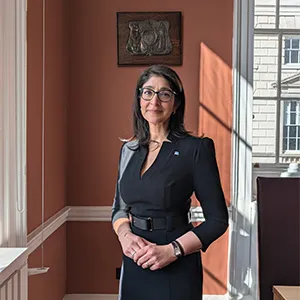 'When I came back to King’s for my fourth year, I wasn’t intimidated any more,' reveals Aarti
'When I came back to King’s for my fourth year, I wasn’t intimidated any more,' reveals Aarti
First steps at King’s
The Strand campus was much smaller when I was at King’s. We didn’t have Bush House or Somerset House. It was just the main building and the School of Law, which was a tiny annexe building at the time.
Outside the law library, there used to be a pay phone and I discovered it was broken. You could put 50p into the slot and it would spit it back out again but still connect your call, so you could make unlimited calls. I had family in Canada, so it meant I could stay on the phone with them for hours. I made the mistake of telling people about the phone and, within a week, there was a long queue of people waiting to use it!
Another highlight was my role as President of the Ballroom Dancing Society. In German culture, it’s very normal to learn ballroom dancing when you are young, so most of the members were German exchange students. This meant I always had a great partner. A former UK champion gave us lessons and, a few times a year, we’d attend tea dances at the Waldorf Hotel in Aldwych. It was amazing.
Adventures abroad
My third year at King’s was spent in Germany, doing a diploma in German Civil Law. That was a massive inflection point for me.
I had no confidence when I started at King’s, having being one of only four students who’d been to a local comprehensive school. A lot of the other students knew each other, having been to the same private schools. Law also required a lot of independent thinking, which was not something I’d been encouraged to do growing up.
Everything changed during my one-year exchange programme in Germany. My talent for languages gave me confidence and meant I was able to truly integrate with German students. I was finally in a place where I was good at something. When I came back to King’s for my fourth year, I wasn’t intimidated any more. I performed much better and secured a 2:1.
A steep learning curve
After King’s, my plan was to become a solicitor. I went to Law School in Store Street and, in those days, the results of the Law Society finals were published in The Times newspaper. Students would literally wait for midnight at Charing Cross tube station for the papers to be delivered. It was both exciting and scary!
I applied to around a hundred firms and got rejected by almost all of them, but finally I found a firm with 80% German-speaking clients who accepted me. However, after completing my two-year training contract, I was the only trainee who wasn’t offered a permanent job.
I was hurt, of course, but I’d come to realise that being a solicitor may not have been right for me any way. I had already applied to do an MBA at a renowned business school in France and I got a place. Funnily enough, my law firm did then offer me a permanent position! I think they were surprised I’d been accepted at such a prestigious institution.
I rejected the firm’s offer and did the MBA, which was extremely difficult as it was bilingual. I had very little work experience and I was told that my chances of finding work afterwards would be very slim. I knew nothing about accounts, statistics or finance, and was way out of my depth.
In the second month of the MBA, I submitted my CV for a job fair with German companies. I was invited for interview by Mercedes Benz and Daimler-Benz Aerospace.
Mercedes Benz rejected me, but Daimler-Benz invited me to Munich to an assessment centre. By day three of the assessment, I realised I had a competitive streak and I was quite thrilled by it all. I thought, ‘I want this!’ and, indeed, they offered me a permanent job! That’s how I got into the space industry. I sort of just fell into it and I’ve been there ever since.
A high-flying career at UNOOSA
In my role at UNOOSA, I help facilitate space diplomacy and international cooperation around the peaceful uses of outer space. UNOOSA is the birthplace of all space treaties, guidelines and principles that underpin today’s global space economy. We also promote the benefits of outer space. This is directly relevant to tracking changes in our climate and environmental monitoring, and building resilience for communities at local level to increasing natural disasters and severe weather events.
People don’t realise the inherent link between space technology, data and sustainable development here on Earth. We’ve been taking pictures of Earth from space for the last 60 years that provide us with a bird’s eye view of melting glaciers and icebergs, shrinking lakes and deforestation. By comparing recent imagery with historical imagery, we can monitor and measure the rate and pace of change. Satellite imagery can even be used to enforce laws, such as for environmental crimes, including illegal fishing, logging or deforestation.
The great thing about the space industry is that you don't need an engineering background to work there. There’s so much good that can be done by applying space solutions to our own planet.
Until then, watch this space…